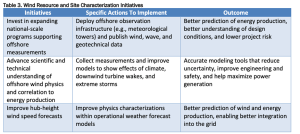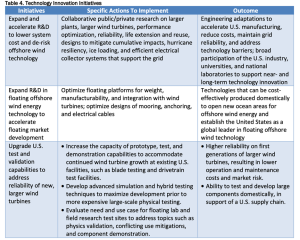TECHNOLOGY GAPS
While the wind industry has seen many technology advancements within the past few years, efforts to improve the performance, lower the costs, and accelerate the deployment of wind power technologies remains a priority. Recently, the focus for wind energy has been on offshore deployment and technology advances.
In January 2022, DOE published the Offshore Wind Energy Strategies report. The report outlines strategies to accelerate the effectiveness of offshore wind energy deployment, which possess a unique set of challenges compared to land-based wind plants. A few of technology gaps it addresses include the need for expanded R&D to address the following technology challenges and lower the costs:
- Floating foundations, which include:
- Anchoring and mooring systems
- Floating platform design
- Integrated platform and wind turbine controls
- Deep water floating offshore wind
- Increasing wind turbine capacity [1]
The following tables appear in that report. They show the various initiatives and specific actions required to implementation with their corresponding outcomes.

Source: DOE Offshore Wind Energy Strategies

Source: DOE Offshore Wind Energy Strategies

Source: DOE Offshore Wind Energy Strategies
in February 2022, DOE’s Office of Energy Efficiency and Renewable Energy Wind Energy Technologies Office outlines three key challenges related to modeling offshore wind energy, which come from a multi-institutional study led by Pacific Northwest National Laboratory (PNNL).
These three challenges are intertwined and must be addressed:
- Scientists must consider of all the various time and spatial scales when simulating interactions among winds and waves and how they, in turn, interact with turbines.
- Observations—or data collected in the field—to validate wind energy models is severely limited, (although DOE-funded Wind Forecast Improvement Project 3 plans to address this challenge by collecting more on-site data within a wind energy lease area along the nation’s East Coast).
- Better understanding is needed of harsh ocean environments in and around wind power plants.[2]
In March 2022, NREL released a Supply Chain Road Map for Offshore Wind Energy, which has been divided into two phases. The main gaps as noted by NREL include:
- Lack of domestic component suppliers. The majority of the necessary components would be sourced from European suppliers.
- Domestic manufacturers would need to also address the following critical subcomponents:
- Yawn and pitch bearings
- Permanent magnets
- Flanges and other large cast or forged components
- Steel plates rolled into monopiles or towers
- Electrical systems for offshore substations
- Mooring chains
- Few existing ports have the needed infrastructure to support the capabilities of offshore wind activities
- The need for new vessels for supporting wind turbine installation and feeder barges [3]
- Domestic manufacturers would need to also address the following critical subcomponents:
Other technology gaps include those identified in the DOE’s 2017 strategic document titled Wind Vision Detailed Roadmap Actions. Wind power goals include the following:
- Improve wind forecasting in minutes, hours, and days
- Improve seasonal forecasting for wind
- Develop models that predict the effect of changing weather patterns on wind resources
- Establish monitoring systems and conduct long-term collection of wind-characteristics data
- Characterize offshore wind resource and external design conditions, including turbine loads from wind, water, ice, and their interactions
- Improve wake modeling
- Develop cost-effective turbine technology for very low wind speeds
- Develop larger wind turbines
- Develop advanced rotors
- Improve drivetrain and power electronics
- Develop advanced control systems
- Develop tall towers
- Develop next-generation foundations and installation systems
- Develop advanced support structures
- Develop new turbine technology systems
- Evaluate solutions to ice loading
- Devise strategies to bolster offshore systems against hurricanes
- Improve distributed wind technology
- Develop a wind plant systems engineering design tool
- Develop aeroelastic analysis for wind plants
- Develop innovative designs (for wind power systems)
- Develop innovative manufacturing technology
- Scale manufacturing capacity
- Develop innovative transportation, construction, and installation technologies
- Establish offshore wind deployment levels sufficient to sustain the supply chain
- Address, understand, and resolve issues related to high turbulence, lightning, and icing
- Identify and adopt operations and maintenance (O&M) practices that reduce disruption to wind plant neighboring communities and wildlife
- Create component retrofits and upgrades that enable improved performance and/or reliability
- Develop advanced active power controls
- Develop and build systems to aggregate power from multiple offshore projects
- Develop strategies to reduce wildlife impacts and expand development of wildlife deterrent technologies
- Develop tools to support wind turbine siting and assessment[4]
To learn more about the needs to achieve the 2030 goal, refer to The Demand for a Domestic Offshore Wind Energy Supply Chain by NREL.
Updated October 2022 by Jennifer Ostromecki

Comments are closed.